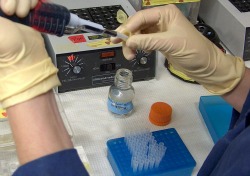Food Allergy Testing: Elimination, Rotation, Food Challenge
Food allergy testing may not be absolutely accurate. Some people testing positive to an allergen never develop an allergic reaction. Some people with an allergic reaction test negatively to the allergen.

Food allergy testing complexity and conclusiveness vary test by test. Some are quite expensive, but are not absolutely necessary. Keep in mind, that most food allergies, hypersensitivities and intolerances are outgrown by the age of one. So if you suspect your breastfed baby’s allergic reaction to a particular food item, before turning to an allergist for tests, try elimination or rotation diet combined with a food challenge.
Elimination diet is eliminating one or all potential allergens from the mother's diet for two-three weeks. Most allergenic food components are dairy, nuts, wheat, corn, soy, gluten, eggs, fish and shellfish. In addition, think of any foods that you craved the most during pregnancy.
I did a complete elimination diet – eliminating all the allergens first, waiting for 3 weeks till the symptoms went away (my son had blood in his stool) and then re-introducing allergens back one by one. Allow one-two weeks between foods. I first re-introduced corn, then wheat, then dairy. Dairy returned blood to my son’s stool, so the doctor concluded dairy was the culprit. Read my story here.
It may turn out that no one particular potential allergen causes an allergic reaction, but a combination. If re-introducing foods one by one doesn’t cause allergic reactions, but once all the food components are back in your diet the reaction starts, do the elimination again, and then re-introduce foods in pairs. Your doctor should be able to guide you through the process.
Important: When on elimination diet, be attentive to your body’s signals. Watch out for withdrawal symptoms – our body is often addicted to the allergen and starts craving it vigorously. The food you crave the most while on elimination diet is most likely the allergen. Keep your doctor informed, as some withdrawal symptoms are quite severe.
Rotation diet is another food allergy testing technique. It is when you eat one potential allergenic food only once every 4 days, watch for reaction the following 3 days. Start a food diary to track your food intakes. This method may not give enough time for the symptoms to begin or go away. But it does work in cases when the reaction is immediate.
If the allergic reaction is severe, re-introduce foods under close supervision of the doctor.
With both diets you have to be extra cautious reading the labels. Even a tiny trace of the unwanted allergen can skew the test results.
After the allergen is singled out, you may try doing a food challenge – re-introducing the allergen after a couple of weeks. Do NOT do this, if the reaction was severe. Since most of the baby food allergies are outgrown, with your doctor’s approval you can do a food challenge every four months.
Food challenge done in your doctor’s office may serve as food allergy testing. It is when a suspected allergen is consumed under close medical supervision. Only one food component is tested every day, as the reaction may be delayed.
All these tests can be carried out at home and are effective to reveal allergies in your breastfed baby. They are inexpensive and easy to implement. If they fail to point out an allergen, your doctor may suggest one of the tests below. Ask the doctor what the earliest age for these tests is.
Other Allergy Tests
Scratch or prick skin test: A small amount of the antigen (allergen) is placed on the skin. The skin is scratched or pricked then to let the antigen inside the body. Skin reaction is monitored. Not recommended for kids under 3.
Patch skin test: A patch soaked in antigen is applied to skin for 1-2 days. Skin reaction is monitored. It is used to test contact food allergy.
Intradermal skin test: Similar to scratch/prick test, but a larger dose of an antigen is injected under the skin surface. Skin reaction is monitored. Some people show allergic reaction to large amounts of food allergens, but tolerate small amounts just fine. This method can test this type of sensitivity.
Provocative skin test: Similar to an intradermal test. A dose of an antigen is injected under the skin surface. Skin reaction is monitored. A smaller dose is injected, followed by an even smaller one until a dose is reached that doesn’t show allergic reactions. This way a safe dose is established.
Serial dilution endpoint titration skin test: Similar to an intradermal test. A small dose of an antigen is injected under the skin surface. Skin reaction is monitored and measured. Then another dose is injected. The goal of the test is to figure out the pattern of allergic reaction and to find out the smallest antigen amount that starts the reaction.
EAV (electroacupuncture according to Voll) skin test: A meter is used to measure electrical reaction of the to an antigen.
Blood count test: In this test red and white blood cells are counted. Based on an abnormal count an allergic reaction may be suspected.
ALCAT (antigen leukocyte cellular antibody testing) blood test: This test evaluates and counts white blood cells before and after exposure to an antigen.
ELISA (enzyme-linked immunosorbent assay) blood test: In this test presence of antibodies to an antigen is revealed through the change of color.
Cytotoxic blood test: In this test white blood cells are exposed to an antigen. Changes in white blood cells are then monitored.
RAST (radio allegro-sorbent test) blood test: A radioactive material is used to mark antibodies. A meter measures the amount of antibodies produced in response to an antigen.
Sublingual tests: These are the tests when an antigen is placed under the tongue. Body reaction is then monitored and measured.
Pulse test: This test takes the person’s pulse successively before contact with an antigen, during, and after. Significant change in pulse means a reaction to the antigen.
Muscle tests: These tests test muscle ability to resist when the body is exposed to an antigen.
Not all of the food allergy testings listed above are suitable for breastfed babies. And since most of the baby food allergies are outgrown, there is no need to go past elimination and rotation diet. If the allergic reactions persist past breastfeeding stage of your baby’s life, talk to your doctor about food allergy testing options.
There are many ways to show your love and devotion to your kids and to win their trust. Breastfeeding is the most natural one.
Yours,
Viktoriya
Back to top of Food Allergy Testing>Food Allergies>Breastfeeding Home










